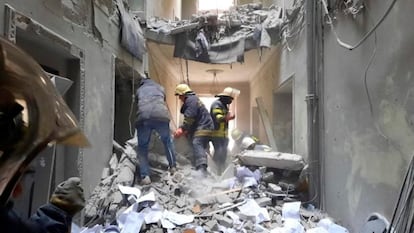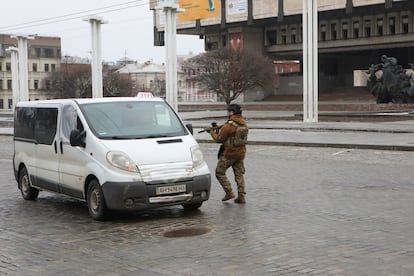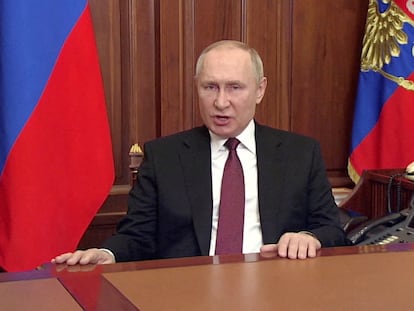Russia warns Kyiv residents to flee city
A line of tanks stretching 40 miles was seen by satellites just north of the Ukrainian capital; a rocket strike reportedly destroyed a government building in Kharkiv


Russian President Vladimir Putin has escalated the military offensive in Ukraine. With Russian troops meeting resistance from Ukraine’s armed forces and civilian militias, the Kremlin launched its most aggressive attacks to date on Tuesday.
While Russia has been claiming that the military offensive is a “surgical operation” against “extremist forces” that would not affect the civilian population, Russia’s Defense Ministry said on Tuesday that it was planning to strike targets in Kyiv used by Ukraine’s security service and warned residents to flee their homes. The first target, a TV tower, was hit in the afternoon. Five people were killed and another five were injured in the attack.
A convoy of Russian military vehicles stretching 40 miles (65 kilometers) was also making its way on Tuesday to Kyiv, according to the news agency AFP. Most of Russia’s ground forces are located more than 18 miles (30 km) north of the Ukrainian capital, which is home to 2.8 million people.
In an effort to isolate the region of Donbas and control the east of Ukraine, Putin launched multiple rocket strikes against the city of Kharkiv, which is the second-largest in Ukraine and home to a large Russian-speaking population. The explosion hit the center of the city and reached the government’s regional headquarters, according to Ukraine’s Emergencies Ministry.
Security camera footage showed the impact of the attack, which took place around 8am, just after the nighttime curfew in the city came to an end. The impact of the missile created a huge fireball that engulfed the cars parked outside the government building, near the symbolic Freedom Square. Anton Geraschenko, an advisor of Ukraine’s Interior Ministry, said that the attack was aimed at killing the governor of Kharkiv and the political leaders of the city.
There is no information yet on how many people have died or been injured in the rocket strike on Kharkiv.”It was terrible,” said Maria Avdeeva, a Ukrainian analyst who lives in Kharkiv. “We were in an open space and had nowhere to hide. The attacks went on for 15 minutes. This is a residential area, with apartments and shops, without any military targets,” she explained by telephone.
The attack on Tuesday came a day after 10 people were killed in a strike against a residential neighborhood of Kharkiv, according to the city’s mayor, Ihor Terekhov. That explosion killed an entire family – the parents and their three children – who were traveling in their car through the affected area. The strikes on Kharkiv are a sign that Russia has changed its strategy in the conflict, which is the largest to hit Europe since World War II. “It showed us that it’s not just a war, this is a massacre of Ukrainian people,” Terekhov said on Tuesday in a message on his Telegram account.

Nearly 90 residential buildings were shelled, while an important education center was also damaged in the attack. Much of the city is now without electricity, water and heating, in the middle of winter, while a number of residents continue to seek refuge in underground bomb shelters.
”This is not a random mistake, but a conscious extermination of people. The Russians knew what they were firing at,” said Ukrainian President Volodymyr Zelenskiy, who has called for Russia to be brought before the International Court of Justice in The Hague for war crimes, specifically the deaths of 16 children who were killed as a result of Russia’s attacks on hospitals and other civilian buildings.
Zelensky has demanded an “immediate” stop to the attacks and called for Russia to be expelled from the United Nations. Moscow, meanwhile, has justified the invasion of Ukraine based on the alleged risk that the neighboring country may acquire nuclear weapons. Putin considers the invasion a “special operation” to demilitarize and “denazify” Ukraine.
Tu suscripción se está usando en otro dispositivo
¿Quieres añadir otro usuario a tu suscripción?
Si continúas leyendo en este dispositivo, no se podrá leer en el otro.
FlechaTu suscripción se está usando en otro dispositivo y solo puedes acceder a EL PAÍS desde un dispositivo a la vez.
Si quieres compartir tu cuenta, cambia tu suscripción a la modalidad Premium, así podrás añadir otro usuario. Cada uno accederá con su propia cuenta de email, lo que os permitirá personalizar vuestra experiencia en EL PAÍS.
¿Tienes una suscripción de empresa? Accede aquí para contratar más cuentas.
En el caso de no saber quién está usando tu cuenta, te recomendamos cambiar tu contraseña aquí.
Si decides continuar compartiendo tu cuenta, este mensaje se mostrará en tu dispositivo y en el de la otra persona que está usando tu cuenta de forma indefinida, afectando a tu experiencia de lectura. Puedes consultar aquí los términos y condiciones de la suscripción digital.
More information
Últimas noticias
Most viewed
- Reinhard Genzel, Nobel laureate in physics: ‘One-minute videos will never give you the truth’
- Oona Chaplin: ‘I told James Cameron that I was living in a treehouse and starting a permaculture project with a friend’
- Pablo Escobar’s hippos: A serious environmental problem, 40 years on
- Charles Dubouloz, mountaineering star, retires at 36 with a farewell tour inspired by Walter Bonatti
- Why we lost the habit of sleeping in two segments and how that changed our sense of time










































